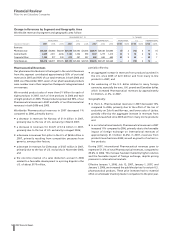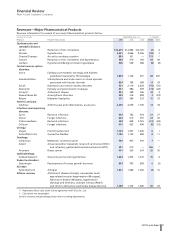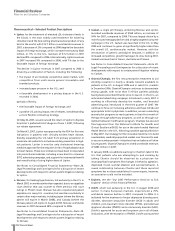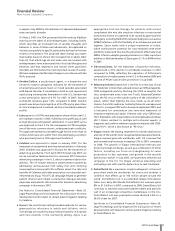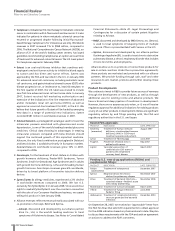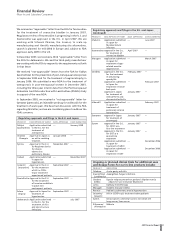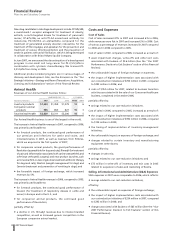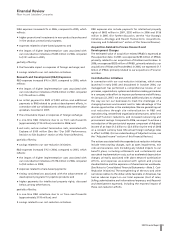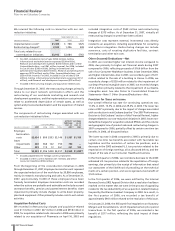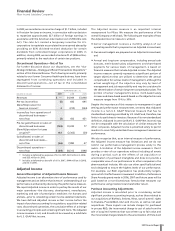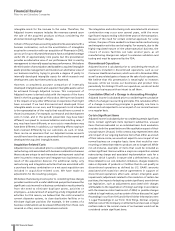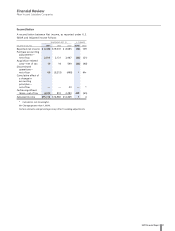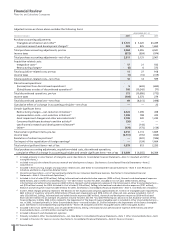Pfizer 2007 Annual Report Download - page 20
Download and view the complete annual report
Please find page 20 of the 2007 Pfizer annual report below. You can navigate through the pages in the report by either clicking on the pages listed below, or by using the keyword search tool below to find specific information within the annual report.
18 2007 Financial Report
Financial Review
Pfizer Inc and Subsidiary Companies
Pharmaceutical—Selected Product Descriptions
•Lipitor, for the treatment of elevated LDL-cholesterol levels in
the blood, is the most widely used treatment for lowering
cholesterol and the best-selling pharmaceutical product of any
kind in the world, with $12.7 billion in worldwide revenues in
2007, a decrease of 2% compared to 2006 despite the favorable
impact of foreign exchange, which increased revenues by $360
million, or 3%. In the U.S., revenues of $7.2 billion in 2007
declined 8% compared to 2006. Internationally, Lipitor revenues
in 2007 increased 9% compared to 2006, with 7% due to the
favorable impact of foreign exchange.
The decline in Lipitor revenues in 2007 compared to 2006 is
driven by a combination of factors, including the following:
• the impact of an intensely competitive statin market, with
competition from multi-source generic simvastatin and
branded products;
• increased payer pressure in the U.S.; and
• a favorable development in a pricing dispute in the U.S.
recorded in 2006,
partially offset by:
• the favorable impact of foreign exchange; and
• a positive U.S. pricing impact, net of rebates, notwithstanding
a more flexible contracting strategy.
On May 30, 2007, we announced the return of Lipitor to Express
Scripts Inc.’s preferred list of drugs as of June 1, 2007, following
our rebate agreement.
On March 5, 2007, Lipitor was approved by the FDA for five new
indications in patients with clinically evident heart disease,
thereby expanding the U.S. label from primary prevention in
moderate-risk patients to include secondary prevention in high-
risk patients. Lipitor is now the only cholesterol-lowering
medicine approved for the reduction in risk of hospitalization due
to heart failure. These new indications have been incorporated
into promotional materials, including a new direct-to-consumer
(DTC) advertising campaign, and support the incremental benefit
and overall safety of using higher doses of Lipitor.
See Notes to Consolidated Financial Statements—Note 20.
Legal Proceedings and Contingencies for a discussion of recent
developments with respect to certain patent litigation relating
to Lipitor.
•Norvasc, for treating hypertension, lost exclusivity in the U.S. in
March 2007, six months earlier than expected, due to an appellate
court decision that was counter to three previous trial court
rulings in Pfizer’s favor. Norvasc has also experienced patent
expirations in many E.U. countries, but maintains exclusivity in
certain other major markets, including Japan (where the Norvasc
patent will expire in March 2008), and Canada (where the
Norvasc patent will expire in August 2010). Norvasc worldwide
revenues in 2007 decreased 38% compared to 2006.
See Notes to Consolidated Financial Statements—Note 20.
Legal Proceedings and Contingencies for a discussion of recent
developments with respect to certain patent litigation relating
to Norvasc.
•Caduet, a single pill therapy combining Norvasc and Lipitor,
recorded worldwide revenues of $568 million, an increase of
54% for 2007, compared to 2006. This was largely driven by a
more focused message platform and a highly targeted consumer
campaign in the U.S. Caduet was launched in the U.S. in May
2004 and continues to grow at significantly higher rates than
the overall U.S. cardiovascular market. However, with the
introduction of generic amlodipine besylate, in addition to
increased competition, growth has begun to slow. During 2007,
Caduet was launched in France, Australia and Taiwan.
See Notes to Consolidated Financial Statements—Note 20.
Legal Proceedings and Contingencies for a discussion of recent
developments with respect to certain patent litigation relating
to Caduet.
•Chantix/Champix, the first new prescription treatment to aid
smoking cessation in nearly a decade, became available to
patients in the U.S. in August 2006 and in select E.U. markets
in December 2006. Chantix/Champix continues to demonstrate
strong uptake, with more than 5 million patients globally
having been prescribed Chantix since its launch. In the U.S., an
unbranded advertising campaign introduced in early 2007 is
working to effectively develop the market, and branded
advertising was introduced in the third quarter of 2007. We
continue to focus on increasing adherence and have introduced
appropriate tools to physicians. In addition, we are conducting
several pilot programs to reach patients in their first month of
therapy through pharmacy programs, as well as through our
GetQuit behavior modification program. Champix has secured
final approval from the National Institute for Health and
Clinical Excellence (NICE) for use in the state-funded National
Health Service in the U.K., following a positive appraisal decision
in May 2007. Our strategy for this innovative medicine is to build
a sustainable, medically supported market over time and to seek
to secure reimbursement—initiatives that we believe will drive
future growth. Chantix/Champix recorded worldwide revenues
of $883 million in 2007.
In January 2008, we added a warning to Chantix’s label in the
U.S. that patients who are attempting to quit smoking by
taking Chantix should be observed by a physician for
neuropsychiatric symptoms like changes in behavior, agitation,
depressed mood, suicidal ideation and suicidal behavior. A
causal relationship between Chantix and these reported
symptoms has not been established. In some reports, however,
an association could not be excluded.
•Exubera, see the “Our 2007 Performance: Decision to Exit
Exubera” section of this Financial Review.
•Zoloft, which lost exclusivity in the U.S. in August 2006 and
earlier in many European markets, experienced a 75%
worldwide revenue decline in 2007, compared to 2006. It is
indicated for the treatment of major depressive disorder, panic
disorder, obsessive-compulsive disorder (OCD) in adults and
children, post-traumatic stress disorder (PTSD), premenstrual
dysphoric disorder (PMDD) and social anxiety disorder (SAD).
Zoloft is approved for acute and long-term use in all of these
indications, with the exception of PMDD. Zoloft was launched










